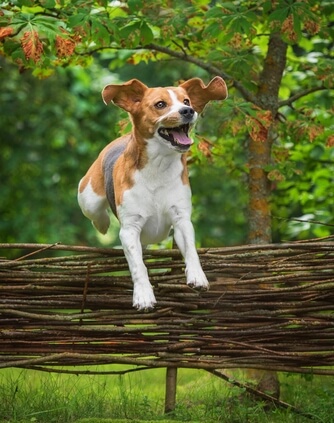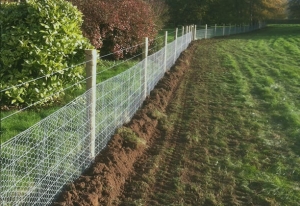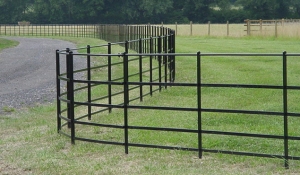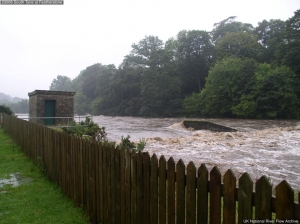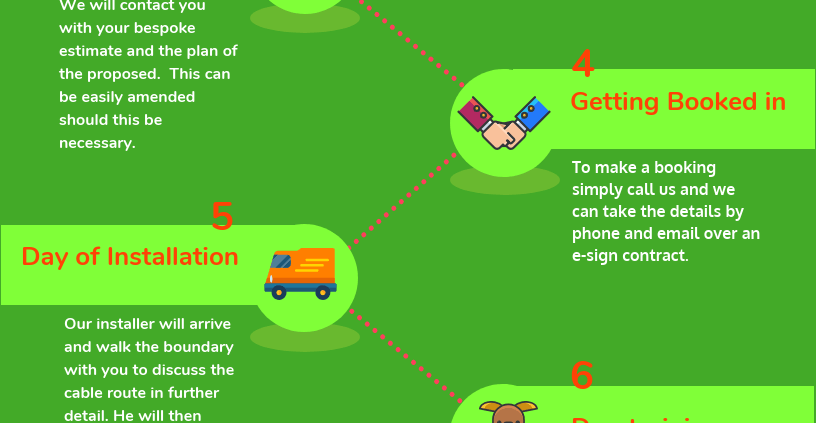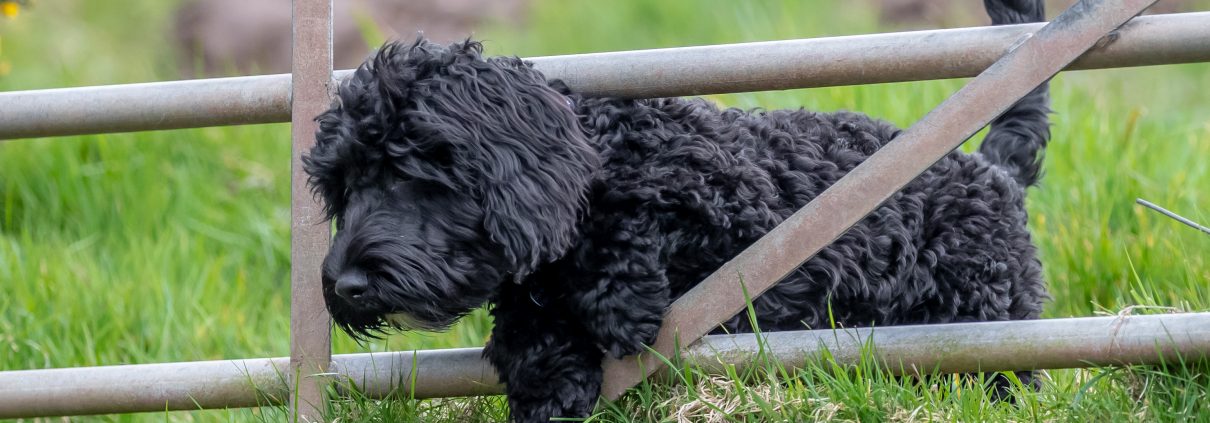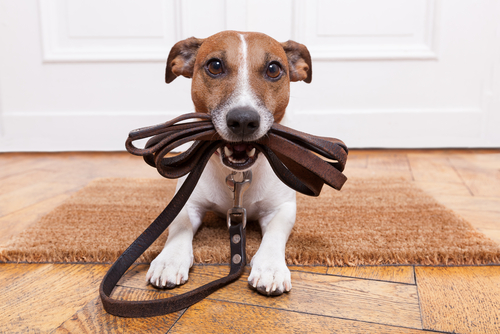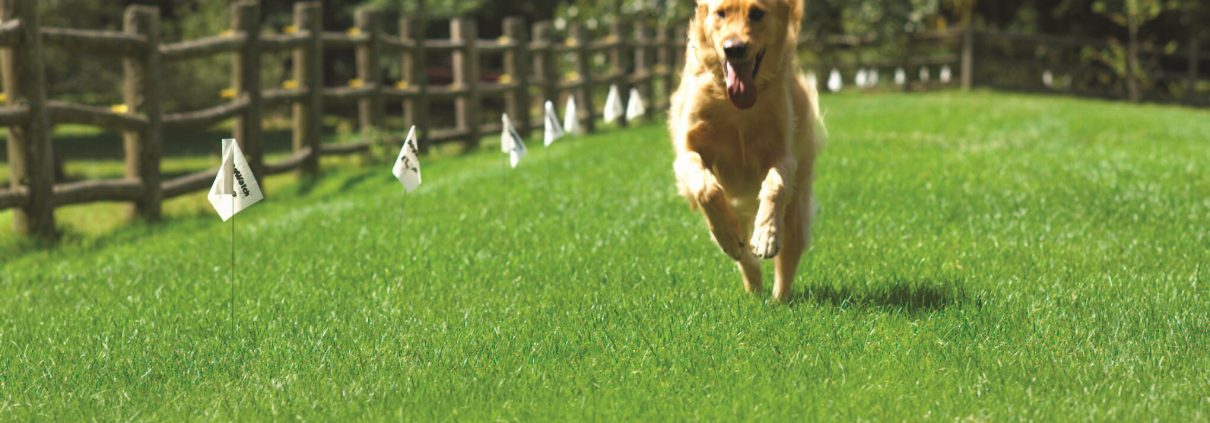Tag Archive for: containment fence
Affordable dog fencing – what are the options?
Affordable dog fencing
When it comes to affordable dog fencing there aren’t many options as fencing is actually quite expensive. As with everything you get what you pay for and it depends on whether you want to get your hands dirty. Naturally, these fencing options are based on how large an area you need to fence. The landscape that you need to fence. And also the breed of the dog that requires the dog fencing!
Dog fencing for small areas
If you are looking to fence a small back garden then it is likely that you already have a fence or wall but it isn’t meeting your needs. Watch your dog and see if he is using something to climb up and scrabble over or is he climbing or digging. Consider installing trellis above your fence. This can be bought from any good DIY store and is relatively quick to install. If you have a digger add a concrete footer below your fence by pouring concrete along the edge of the fence and sinking the bottom of the fence into the concrete before it dries. This is naturally a labour intensive job but should do the trick!
If you are not sure where he is getting out then one of our DIY dog fences is going to be the cheapest way forward. These fences are under £250.00 and will cover a small urban garden. If you compare the price of re-fencing a complete rear garden versus adding an electronic dog fence the dog fence will win on price all day long!
For small gardens with low fences, you may be able to upgrade your fence to a close board fence. These fences start at around £38.00 per metre fully installed. You will need to check that you can install a fence of this height before ripping out the old fence.
Rural gardens and small paddocks
It goes without saying that dog fencing for rural areas can be a headache. Not only are you trying to stop your dog going out but the local wildlife is busy pushing its way in. If you have an issue with rabbits and small dogs then this could be a good option for you but it is not the cheapest! Rabbit fencing starts at approx £130.00 per 50m without installation! If you are covering a 1-acre site this will cost in the region of £690.00 just for the galvanised mesh without any posts of labour. Also unless it is extremely well-installed rabbit fencing can be damaged by larger mammals such as Badgers, Muntjack and larger Deer.
If you have hedges or areas with no existing fences then the cheapest form of fencing will be either a stock fence or an electronic dog fence. If you have horses or livestock then you will need to look at stock fencing options. Of course, if it is only a dog or a cat that needs containing then an electronic dog fence is by far the cheapest option.
Our DIY dog fence can be expanded up to an acre for an additional £100.00 and a Professionally Installed dog fence will cost in the region of £1000.00 depending on the location and number of dogs. This would work out more cost-effective than the galvanized or stock fencing and would also protect the driveways. Installing gates can also be very costly and of course, this relies on people shutting the gate when they come or go! Our Professionally installed fences have a lifetime warranty on the hardware and a containment promise for the dog.
Large estates and difficult terrains
If it aesthetics then Estate fencing is most certainly the winner but you will need deep pockets to install this timeless classic! At around £80.00 per 2m panel + installation, it will very soon add up, especially on the large country estate! Again, you will need to think about gates and this type of fencing is not dog secure. Other popular types of fencing are post and rail with stock fencing below or chain link fencing. Chain link fencing is probably the cheapest starting from around £2500 for 1 acre + installation. Whereas if you are looking at fencing 10 acres using our Performance Series on a 10-acre site the cost would be circa £1800.00 including installation & training.
Riverbanks and Undulating Terrain
If your property goes down to the river you may be able to install a small picket fence. These will not stop all dogs as they tend to only be a 90 cm – 100cm high. Prices for Picket fencing start at around £12.00 per metre plus installation. Alternatively, you can use our dog fence to run along the boundary. This will keep your dog out of the river without disrupting the view. If you have very undulating terrain then you will probably need to install a stock fence but there would be a hefty surge-charge to install this! Again, an invisible fence can be installed for a fraction of the cost. The trencher used to install the invisible dog fence is extremely adaptable and be operated in both steep and undulating terrain. Images of the dog fence trencher can be seen on our installation & training page.
Dog Fencing price summary
Based on an acre (and excluding gates)
-
- Electronic dog fence (1 dog fully installed – covers gateways as well) – from £3.50 per metre installed.
- Stock Fencing (no gates) – from £7.00 per metre installed
- Rabbit Fencing (no gates) – from £8.00 per metre installed
- Stock Fencing with post and rail (no gates) – from £12.00 per metre
- Picket fencing (no gate) – from £20.00 per metre
- Close board fence (no gate) – from £35.00 per metre installed
- Estate fencing (no gate) from £40.00 per metre installed
Prices have been based on submissions from Companies in Berkshire (2019). Prices are based on properties in the local area and are a guide.
If you have been searching for dog fencing options then read our testimonials on our Trust Pilot reviews. If you would like more information or prices call us today on 03450 623623 or complete our quote form.
Electronic dog fence – FAQ’s for new customers
What You Need to Know About our Electronic Dog Fence: FAQ for New Customers
Booking a dog fence installation
Dog fence day
As a general rule, we commence the dog fence Installation will commence circa 07.30am! Interestingly this is to avoid rush-hour traffic and maximize daylight during the winter months. Our Installer will walk the boundary with your to fine-tune the electronic dog fence route. Once this has been agreed we should not need your attention again until we commence the dog fence training.
Our unique trenching equipment will bury the cable directly into the ground. We endeavour to bury boundary cables but if the terrain or an area is not suitable we can install cable above ground. Of course, the installation duration will vary depending on the size and the terrain but as a general rule, we will be ready to train your dog in the afternoon.
Electronic dog fence training
Now for the magic! We will not hook your dog up to the mains, we will not hurt your dog, we will train your dog using a recognised protocol. Actually, the training is very subtle and for some dogs, the scariest part is the temporary training flags. These little “flag” aliens can be quite scary to some dogs and others will play or stalk them. As with people, all dogs are different as we will treat them as individuals. The flags are a vital part of the training and will give the dog a visual for the electronic dog fence boundary.
Don’t worry! Your Installer will look after your pet, he will involve you in the training and you will be amazed at how quick and simple the training is. All our Installers are trained to offer the full Dog Fence Installation & Training program. They will find the level suitable for your pet and work to ensure that he or she understands the fence.
Hopefully, he will answer all your questions but if you forget anything or you have a query you can call the office after the installation. The notes from the day will be electronically uploaded so we can access the training info and answer your questions.
Does the electronic dog fence come with a guarantee?
Absolutely! DogFence offers the most comprehensive guarantee worldwide. Our lifetime hardware warranty covers the transmitter & computer collar for life and even extends to dog chews. But more importantly, we offer a Containment Promise on professionally installed, outdoor systems.
Should your system break down for any reason you can also schedule a service appointment and one of our engineers will test or repair your entire fence or train any new pets that you may have acquired.
Is there any ongoing maintenance for the fence?
Naturally, it is important to check the fence from time to time. At DogFence we recommend testing the electronic fence monthly. This would include checking the battery and collar fit and takes less than 5 minutes. The electronic dog fence collars will alert you when you require a battery. After the dog fence installation, you will be invited to sign up to our battery program. If you decide to purchase batteries on an ad-hoc basis that’s fine. But it is important to remember that when the battery runs out the pet can run out! Other than the battery and checking the collar fit there is no ongoing maintenance required.
How often do I replace the battery in my dog’s Computer Collar?
Of course, we all lead busy lives but once you see the red flashing light on your electronic dog fence collar you need to take action. The schedule for the battery changes is as follows:
- R12m & R7m (mini) collars – every 6 months
- R12 & R9 (standard collars – every 18 – 24 months
The green status light will change from a steady flash every forty seconds to a rapid flash every 10 seconds. At this point, you have approx 2 weeks to change the battery.
Where can I buy Batteries?
DogFence offers a few different options for customers to replace batteries.
How often should I remove the electronic collar?
VVIP – the collar needs to be removed every day! Leaving the collar on the dog can cause a skin irritation. We strongly recommend that you remove the collar for a minimum of 6 hours every day but we recommend 8 hours. On the day of the dog fence installation, you will be given all this information again together with a continuation sheet to assist you in the early days’ post installation.
If you would like to know more about our electronic dog fence please call us. We can chat to you and pop together an estimate for the dog fence installation – 03450 623623 or info@dogfence.co.uk.
Invisible dog fence – can pets out run them?
Can dogs run out of an invisible dog fence?
When looking into purchasing an invisible dog fence one of the most commons concerns is will it work? Can the dog run out of the containment fence? Of course, just a like an ordinary fence if the fence is broken or poorly installed it won’t work. So as with any product, an invisible dog fence needs to be correctly installed but more importantly, both the dog and owner need to know how to use it.
If the fence is correctly fitted and both the pet and owner are trained then a “dog out” will rarely happen. In fact, at DogFence we are so confident we even offer a containment promise on our fully installed dog fences.
So what are the reasons that a dog may outrun a dog fence system?
1. Dead Battery
Unlike other brands of containment fences, our Invisible Dog Fences have a long battery life. However, it is still important to check the battery using the tester every 6 months on our mini collars or 18 months on our larger collars. Consistency is the key to the successful use of an invisible dog fence. If the battery runs out the dog can run out. As a rule, we find that 60% of our troubleshooting is down to a dead battery. Using an invisible dog fence is similar to using your car, it requires fuel to operate and needs topping up and checking once in a while.
2. Loose Collar
As with all brands of containment fence, collar fit is crucial. If the collar is dangling around the dog’s neck like a necklace then it will be completely ineffective! Whilst it is true that once trained 90% of dogs will never receive a collar stimulation again the impulse may need to be activated if the dog is in a high drive moment. If the dog enters the zone and carries onto in the avoidance area with no consequence he or she will quickly learn to challenge the fence. A loose collar = a dog on the lose. We always advise checking the collar fit regularly – your pet may lose or gain weight so checking the collar monthly is extremely important. Our handy troubleshooting guide shows how to test the battery and check the collar fit.
3. Invisible Dog Fence Training – lack of Training
As with anything in life you only get out what you put in! When it comes to containment fencing Training is the keyword. If your pet is not correctly trained to use the fence then it will not work for you or your pet.
DogFence is the only UK Company to offer full onsite training within the package. In 2018 the UK Government announced that they would introduce new legislation to ensure that all dog fences are sold with an installation package. At present, the legislation is still pending. It is hoped that through this legislation there will be a standardized certification program. As a small part of our customer base chose to self-install a DIY Dog Fence we offer full support. Naturally, unlike a total mail order Company, our years in the field mean that we can offer expert guidance and support to those who chose to self-install.
When is come to containment training there are 4 critical elements:
- Warning flag & audible only familiarisation
- Introduction to correction (impulse)
- Distraction Training
- Reinforcing Training
Warning Beep Training
All invisible dog fences should be sold with flags – at DogFence we use a min of 20 per 100m. The collar should be set to audible only and the pet should be introduced to the training flags. It is with warming beep that will stop the pet in a red mist or high drive moment.
Introduction to correction
The pet must be on a lead through phases 1 – 3 at all times. This is part of the training where the correct impulse level is determined for each pet. It is important to start on the lowest possible level and look for any signs of recognition/reaction to the impulse. This could be as subtle as a flick of the ear of a small flinch. All good containment fence collars should have flexible training levels.
Distraction Training
Once the pet is avoiding the training flags it will be necessary to create some distractions. These can be getting a game going with the pet, having someone else walk through the flags or bringing another dog to the property. Our DogFence Installers will usually involve the customer as part of the distraction and it’s a great way for the owner to really get involved.
Reinforcing Training
Once the pet fully understands the containment fence it is important that he or she associates it with the property and not the installer. The installer will leave full written instructions on how to carry on and when to allow the dog off the lead (cat training is carried out internally).
Freedom!
Once trained the pet has complete freedom and the owner has peace of mind.
4. Faulty equipment – Not all Containment Fences are the same!
Dogs will be dogs and the invisible dog fence collar goes through a lot of wear and tear. Many brands of containment fences are Chinese made and the quality is poor. Our invisible dog fences are high-quality but even these can go wrong. Recognizing that consistency is king DogFence offer a Lifetime Warranty on our professionally installed fences. The warranty covers both the transmitter and the computer collars. And because dogs will be dogs we add in a warranty to cover dog chews on the computer collar as well!
As with a car, it is important to check things are working. Our Installers will show you how to carry out the simple monthly checks using the testing tool. Using the correct battery is extremely important. A good quality containment fence collar should alert when a battery is required. At DogFence we recognize that people are busy so we also offer an automatic battery renewal programme.
Similary boundary wire quality is vitally important. If the boundary wire is too thin it will be very prone to damage. DogFence uses a high-quality heavy-duty boundary wire which is 25 times heavier than most DIY brands supply. When looking for an invisible dog fence look for the following:
- Long Battery life

- Lifetime Warranty on Transmitter & Collars
- Heavy-duty wire
- Professional Installation & Training
- Full after sales service
Escaping dogs will always be a problem as they can cause road accidents, kill or harm livestock or wildlife. Using a containment fence is an excellent way of giving the pet freedom but keeping them safe at home. Not all containment fences are the same and not all containment fence suppliers offer the same level of service. If you would like to receive some professional advice and information call us on 03450 623623.
How do I take my dog for walk if I use a dog fence?
How do I take my dog for a walk if I use a dog fence?
After you have had your dog fence installation one of the most common questions we get asked at DogFence is “how do I take the dog for a walk?”.
It’s actually really simple. The DogFence installer will have trained your dog or cat to stay within the dog fence boundary. This is a reverse training protocol and usually takes the dog approx 7 – 10 days to feel fully comfortable with leaving the property.
There are 2 main points to observe:
- Never allow your dog to cross the boundary unless he has contact with you. This could be with the lead or by carrying him or simply having a hand on his shoulder.
- Never allow your dog to cross the boundary with his fence collar on – even with the system turned off.
To cross the boundary:
- Remove the dog fence collar and put it in a safe place. Do not turn off the fence.
- Pop him on his lead and walk him up to the exit.
- Ask him to sit or stop him before the boundary line (only for the first week).
- Give the command to walk and walk slowly out of the property.
- Give him praise when you have crossed the boundary.
- Repeat the process when you re-enter the property.
The best way to see how it works is to watch the lovely Lionel demonstrating how it’s done:
When we install a dog fence for you we will run through how to take your dog for a walk after. As with any new training, it may take your dog a few days to adjust to going out for a walk. If you would like to learn more about how we can give your dog freedom in the garden check why not call us today on 01628 476475?
Dog Fencing Ideas – how to keep Fido home!
Dog Fencing Ideas – solutions to keep Fido safe
Dogs will be dogs so exploring different dog fencing ideas is a must for any canine owner. Having spent 17 years fencing dogs we have come across many different ideas. As with people no two dogs are the same and of course they all live in different locations.
Rural dog fencing ideas
Many rural locations are difficult to fence. Understandably this could be because of the terrain being very hilly, wooded or prohibitively large. Furthermore most rural properties are surrounded by hedgerows. Hedgerows may be a deterrent for a dog with a low prey drive but for many it’s an open avenue of escape.
Stock Fencing
Stock fencing is a traditional dog fencing idea for rural properties. Used to contain livestock it is adaptable for use in rural gardens. For many dogs this will give enough of barrier to prevent the dog jumping out of the property. The downside is that this type of fencing is it is costly, unsightly and can be damaged by wildlife. Badgers and foxes will often make holes in this type of fencing and thus some rural owners find this dog fencing idea a temporary fix. Also the cost of such fencing can work out extremely expensive; starting around £6.00 p/m + gates etc it can a costly exercise.
Deer Fencing
Deer Fencing; again another great rural solution but sadly it is extremely obtrusive more expensive than stock fencing. Again, the downside with this fencing is that badgers and small mammals will make holes that then become an escape avenue for your dog!
Electronic dog fencing
Electronic dog fencing; you may not be familiar with this product even though this type of dog fencing idea has been around for over 40 years. Using a boundary wire, transmitter and a computer collar worn by the pet this type of fencing can be used on any terrain. Electronic dog fences do need to be professionally installed. This is because the pets need training but they a more cost effective solution than traditional methods. As a guide price an rural installation of approx 2 acres for 2 dogs would be circa £1300.00.
The advantage of this type of dog fencing idea is that it can be used cost effectively on very large properties (up to 350 acres) and can be removed if the owner moves house. It is also invisible so will not affect any planning restrictions or spoil the view!
Kennels and dog runs
Kennels and dog runs are full proof method for dog containment. The downside of installing a run is that many dogs become bored and exercise is limited. The cost of installing Kennels can be high but equally these can be relocated to a new property.
Urban dog fencing ideas
Most urban gardens are fenced in some way but these may not all be dog proof! Some new sites have planning restrictions on fence heights and even open plan. Many properties use Picket or Rail type fencing which dogs can easily jump over or squeeze through.
Planning permission is not usually required in urban areas. Fences must be no more than 2m high or 1m high near roads. The most popular type of fencing is for urban houses is Close Board fencing.
Close Board Fencing
Close board fencing is a great dog fencing idea for many urban owners. It is generally tall enough to stop jumping dogs and quick to install. This type of fencing comes in varying heights and can be installed by most handymen. The downside is that some dogs will dig under and there may be restrictions to installing this type of fencing on some new estates. As a rough cost to install on a small rear garden it would be approx £1200.00.
Electronic dog fencing – no need to install gates!
As with the rural properties this type of fencing is a very cost effective solution. This type of dog fencing idea also gives the owner the possibility of protecting the drive within the price. It is true that the larger the property for more cost effective the electronic dog fence becomes but small properties can also be fenced with this product.
Many owners may already have a Close Board or Picket fence installed and need additional backup. The electronic dog fence can be run around the existing fence if the traditional method is not working. Our Installers can place the cable to prevent the dog jumping over or digging under the existing fence. The cable can even be run under the drive to protect this area. Most owners are concerned that this means digging up the drive but the installation is both neat and discreet. A typical urban property would cost less £1000 to fence and this would include a driveway loop.
Cat Runs
Interestingly cat runs can be used to keep both dogs and cats safe. These type of structures can prove expensive if they are professionally installed and may not be aesthetically pleasing. A cat run suitable for a dog would usually cost from £750.00 upwards depending on the size.
A DogFence Ltd we have been Professionally installing electronic dog fences for over 17 years. The dog fencing ideas that some owners come up with to keep their pets at home can often be amusing. Over the years we have seen:
- Old Fireplaces in the hedge!
- Old garage doors down one boundary!
- Orange builders netting – not attractive or effective!
- Hundreds of dogs on tie out stakes – who have wound themselves up to the pole 🙁
- Electric horse fencing – Harsh and not fall proof!
If you would like to learn more about how we can keep your dog safe at home please call us or visit our web site. We offer bespoke Quotes using our online measuring tool – simple, accurate and effective. 01628 476475 or info@dogfence.co.uk
Electronic dog fence – How to train your dog.
Simple Steps for training your dog to an electronic dog fence
Before commencing electronic dog fence training:
- Ensure that you have the correct amount of training flags to cover the boundary. The training flags are the most important part of the training protocol for electronic dog fences. The training flags should be placed approx 8 – 10ft apart around the boundary. Use the collar to find the edge of the avoidance zone and place the flag in the ground in the area where the collar starts to beep.
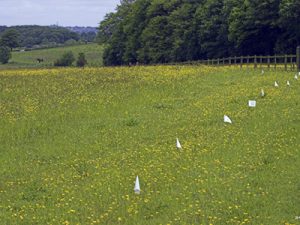
- Using the dog fence tester – set the collar to beep only mode. This means that the collar will not give out an impulse just an audible tone.
- Place the electronic dog fence collar on the dog and check that it correctly adjusted. As a guide you should be able to get 2 fingers in the neck strap when the dog’s neck is down. See our Trouble Shooting page for handy tips.
- Leave the collar on the dog for at least 30 mins before commencing the initial training session.
- Find a long lead – 6ft and ideally not the dog’s usual walking lead.
Commencing the training
- Take the dog outside on the lead.
- Walk the dog around the boundary and tap the flag so that there is good movement.
- As you tap each flag use a command word – a good example is “Watch out”.
- Allow the dog to go past the training flags into the correction zone (this is the area of the electronic dog fence where the collar will give both a beep and impulse). Allow the dog to linger here and hear the warning beep then direct him back into the garden. Use the command word and tap the flag again.
- Repeat this around the boundary for several small sessions over 1 – 2 days.
Introduction to Correction
- Place the electronic dog fence collar on the dog approx 20 – 30 mins before starting the training.
- Using the tester – lift the level on the receiver from level 0 (beep only) to level 1.
- Repeat the process of walking around the boundary and tapping the flags. Always use the command word when tapping the flag.
- Allow the dog to go past the flags into the avoidance zone. Look for any signs that the dog is feeling the impulse (a small twitch of the ear, little shake of the head).
- Carry on around the boundary allowing the dog to walk into the avoidance zone of his own free will. Never call or drag the dog into the electronic dog fence zone.
- If the dog is not responding to the level – lift the level to level 2 and repeat the process. Always direct the dog back into the safe area and praise the dog when he is back in the safe zone.
- Once the dog is reacting to the stimulation make a note of the level.
- After training play with your dog, praise him and reward him. Do not allow the dog to be off the lead in the garden during the training phase.
Introduction to Distractions
It is important the dog fully understands the warning beep and how to retreat when he is in a high drive moment. By carrying out the distraction training your dog will learn the electronic dog fence so that it becomes second nature. This will ensure that even when he is in a high drive state he stops at the warning beep. The distraction training will require 2 people.
- Walk around the boundary, tapping the flags and then have the new person walk into the flags and well into the avoidance area. See if the dog continues or decides to stop.
- If the dog continues allow him well into the zone to receive the stimulation and guide him back to you in the safe area. Give him the command word whilst guiding him back to the safe area. Praise him in the safe area.
- If the dog stops before or at the flags guide him back and praise him.
- Continue walking around the boundary and repeating the process.
- Once the dog is making the right decision (not walking into the flagged area) move on and try this on the driveways or open areas.
- If the dog is making good progress you may wish to drop the lead and walk into the flagged area with the companion. If the dog endeavors to follow give the command in aloud and firm voice.
- A good indication that the dog is fully at home with the electronic dog fence is when he looks away from the flags.
Repeat this process over a couple of days.
Letting your dog off the lead
- Walk the dog around a couple of areas and tap the flag if possible. Usually by this stage the dog will not venture near the flags so just give the command word even if you are several feet away from the flag.
- Go to the centre of the property and face the dog away from boundary.
- Remove the lead and start to walk back towards the house or a safe area.
- Play with your dog outside – you can roll a ball but always roll away from the avoidance zone.
- Do not leave the dog unsupervised in the garden for the first few days.
- After 14 days you can start to remove the flags. Remove the flags every other flag, every other day until they are gone.
Keep the flags in a safe place as if you wish to add on another pet you will need to re-flag the boundary and if you change the layout this will need to be re-flagged to give the dog a visual.
Points To Remember
Training your dog to the electronic dog fence should be fun!
Never throw a stick or ball into the avoidance zone.
Small bit size sessions are often better.
Always remove the dog fence collar at night or for a period of 8 hours in every 24 hour period.
Check the fit for your electronic dog fence collar regularly.
Check the battery status on your collar monthly (using the tester supplied).
DogFence Ltd are the largest installers of electronic dog fences in the UK. Our professional installer/trainers can set up your dog fence for you and will train your pet to the system. We also offer a post installation service to train new pets to the system. If you would like more information please call us on 01628 476475 or email info@dogfence.co.uk.
A dog is for life!
A dog is for life – t’was the month before Xmas T’was a month before Christmas and all around the house the children were squealing we want a pet mouse; Or a hamster, a kitten, a dog or a horse. We PROMISE to look after it forever, of course! So straight onto Google the parents […]
Fencing For Dogs Who Escape
Fencing for dogs – Which Fence Is Best?
Here you are finding yourself researching about fencing for dogs. I am guessing your canine companion is one that is a great escape artist! I have one too and not one who jumps over a fence but one who finds the smallest gap and squeezes himself out or it maybe you have a high energy dog who just loves attention from any passing people or other dogs, whatever breed you own, a dog is always on the lookout for freedom to roam.
Frequent escapes create a number of worries for you as a pet owner:
- Theft.
- Become a bait dog.
- Poisoned.
- Even shot for chasing livestock.
- Picked up by the local dog warden (which costs you).
- Be at risk of injury or hit by a moving vehicle.
All of these worries are real today! Dogs do not see these dangers, they escape because they can and often if left for long periods of time, because of boredom.
There is a simple solution to this issue of fencing for dogs and that is for an invisible or hidden fence. Whereas a static fence:
- A dog can jump over.
- Dig its way out underneath.
- Chew through in a bid for adventure or someone to be with.
Interestingly, people often say a dog can run through the wired or wireless system – however…read on and you will see why this is and why DogFence systems do not pose this issue.
Wired or Wireless Fencing For Dogs
Sadly, there has been much stigma about electronic fences and shock collars but the collars available today are far removed from the collars available 40 years ago. Today’s systems have improved massively in terms of stimulation levels, size of receiver collars, training etc. People are concerned that these fences may be illegal. All our DogFence systems are 100% legal. Of course, our legal dog fences come with patented fail-safe FM radio frequency technology. Unlike the AM frequency dog fencing systems, it will not fail or activate accidentally.
Wireless dog fence
Most dog fences are wired but wireless systems are available but are often not as effective due to the constraints regarding lay of the land etc. With the wireless installations, there can be issues with undulating terrain, trees, and building and these types of pet fence are highly prone to false activation. Whilst they may be quick to install, sadly the end result can be confusion for the dog. As with any Pet Training protocol it is best to take time. Taking a day or so to install a wired fence will give your dog more freedom. If your dog is happy and safe then this will also give you peace of mind as well.
Of course, wireless dog fences have a few advantages over their wooden or chain-linked counterparts. Many electric dog fences require few tools to install and can be set up in an afternoon. Unlike a traditional gate, the layout of many invisible dog fences isn’t as restricted by the topography of your garden. Using an invisible fence does not obstruct your view, it is ideal for creating a space for your dog. A wireless dog fence allows you to increase the range of your boundary area. You can link additional receiver collars to increase the range of the signal.
What is an Invisible Dog Fence & How Does It Work?
- An FM radio signal created a virtual fence. Dog Fence uses the Safelink patented FM digital technology.
- 15 times faster than AM radio signal fence systems.
- An invisible fence can cover a large area (at a fraction of the cost of traditional fencing).
- The radio signal transmits to a collar worn by the pet.
- A zone before the boundary triggers a high pitched beep from the collar, to warn your pet.
- At the boundary, your pet gets a warning beep and small static impulse, through the collar.
- Temporary training flags are installed to give the pet a visual
- Through training, the pet learns to retreat to a safe area.
- Maximum protection against false activation.
- If a correctly trained a dog cannot run out of an FM radio signal.
- 2-5 days training programme for your pet.
- Suitable for dogs over 12 weeks and cats over 16 weeks.
- Discomfort from the impulse, experienced by your pet, occurs mainly during the initial training. It feels no worse than an annual vaccination. The stimulation cannot compare to the pain of being hit by a car!
- Costs a fraction of the price of installing a traditional fence.
Conclusion
All things considered, the best fencing is a hidden containment fence, one which transmits over FM frequency. After all, we are pet lovers and the importance of our pet’s safety should not be underestimated. Pet shelter organisations do require you to have secure fencing in place before approval of adoption too. With other types of fencing for dogs, a pet has the means to escape. You want peace of mind that the fencing you choose is secure enough to keep your pet safe.
To conclude, hidden legal dog fences are the best choice, due to the following factors:
- They are highly effective at pet containment.
- The fence is invisible and does not obstruct your view.
- A cost-effective solution that allows freedom for a safer, happier, independent pet.
- An easier life for you the pet owner having less worry.
- They are professionally installed.
DogFence Ltd offers a pet training programme as part of its installation service. This is designed to minimise the static shocks, to your pet, by ensuring can teach your pet it’s new boundaries. So don’t wait, get in touch with our friendly team here at Dog Fence today for an informal chat about fencing for dogs to suit yours & your pet’s needs.
Related posts:
Electric Dog Fences Weighing Up The Pro’s & Con’s
Electric Dog Fences Are The Cruel
8 Top Tips To Stop Dogs From Escaping
Containment Fences Explained
What are electronic Containment Fences and how do they work?
Containment fences hit the news earlier this year when the Government declared that they intended to ban e-collars for training dogs.
Sadly, the media jumped in with both feet first and declared that containment fences were also to be banned. At DogFence we were horrified having Professionally installed containment fences for over 17 years we had no idea why! For our customers that already used a containment fence there was outrage. How could the Government even consider banning a fence that had saved their pets life and given them back their freedom? For those that had not heard about containment fences there was intrigue. What is a containment fence and why do they want to ban them?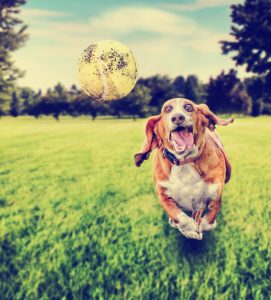
Even the MP that called for the ban didn’t know if the containment fence was to be included within any ban and the officials at DEFRA did not know how containment fences worked! As experts in the field for containment fencing DogFence were invited to meet with officials from DEFRA and demonstrate the fence.
The comments from the DEFRA team were as we suspected “it’s not that bad” and “it’s not what I imagined”.
So what is a containment fence?
It’s actually an invisible fence or virtual fence which is created by a radio signal. Originally invented to keep dogs safe at home in the USA where gardens are traditionally unfenced their popularity has grown in recent years.
A containment fence is actually a very simple and unobtrusive system which can be installed on virtually any property at a fraction of the cost of traditional fencing. It also offers for safety than conventional fencing as the pet can’t dig under or jump over the fence and it protects open areas such as driveways.
A boundary wire is placed around the property boundary which transmits a coded radio signal to a collar worn by the pet. When the pet approaches the boundary wire a high pitched warning beep alerts the pet to go back. If the pet continues forward, an electrical impulse is given through the collar (this is often referred to as a correction or static shock) and the pet retreats back into the safe area.
How does the pet know where to go?
Every pet undergoes a training programme which usually takes 2 – 5 days. When training to a containment fence it is important that the boundary is flagged to give a good visual of where the virtual fence starts. The flags stay in the ground as a visual marker for approx. 2 – 3 weeks. Containment fences can be used for dogs over the age of 12 weeks and cats 16 weeks or over.
The trainer will take the dog outside and set the collar to “beep only” mode. Using some voice commands, he will introduce the dog to the containment fence training flags and later he will allow the dog to enter the “no go area” of his own accord. By re-focusing the dog back into the safe area with the assistance of the warning beep and vocal commands the pet will quickly learn where he can or can’t go. Following the beep only session the training moves onto to assess the correct level of impulse (correction) required for the pet. If the owner has more than one pet the likelihood is that they will each have a different training level.
With cats the training is carried out internally following the Dog Fence Cat protocol. This training protocol was used as part of the Lincoln Cat Containment Fence study.
Will the containment fence hurt my pet?
Of course the thought of giving any impulse or shock to your pet can be abhorrent. It is important to note though that the impulse is very low and is usually only felt during the training phase. The sad scenario is that the pain felt from a car is almost unimaginable and the discomfort of containment fence is no worse than an annual vaccination. Also for dog owners there is always the threat of a shot gun as dog attacks on sheep are rising annually.
What areas of the garden will the containment fence cover?
Interestingly, containment fences can cover the entire garden including the driveway. The largest installation that we have installed at Dog Fence is 450 acres. Usually the fence wire is dug directly into the ground (approx. 3 – 5” below the surface) but it can be attached to existing physical boundaries. It is not uncommon for the fence wire to be attached to post and rail fences, stone walls, run through hedges, ditches or streams and even the odd moat! When it comes to the driveway any surface can be crossed except Resin bonded drives which require special attention.
Containment Fence Collars
The original containment fences from the early 80’s used heavy bulky collars but as with the mobile phone technology everything has been scaled down in recent years. Not only have the collars become smaller and lighter but the battery life has also increased.
At Dog Fence we can boast the smallest and lightest collars worldwide. Our mini containment fence collar only weighs 30g but still features an incredible 6-month battery life. Incredibly our standard collar has a 2-year battery life and weighs in at only 48g which is still the 3rd lightest collar available worldwide!
How much do containment fences cost?
A containment fence costs a fraction of the cost of installing a traditional fence or driveway gates. Unlike a wooden or stock fence a containment fence becomes more cost effective the larger the area. Naturally the price is dependent on the owner’s location and the number of dog or cats that they have. There is no need to visit a property to give an estimate for the containment fence; this can all be carried out via our online survey tool.
Summary
Thankfully, the Government looked at the evidence, research and responses from containment fence owners and deemed these lifesaving systems safe to use. Indeed, Michael Gove stood up and supported the life-saving fences in Parliament.
If you are interested in receiving a quick free quote contact us today on 01628 476475 or fill in our quote form https://dogfence.co.uk/quote/

